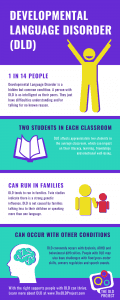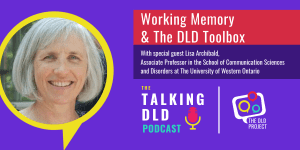Are you passionate about raising awareness of DLD and helping people to know the basics? We are too! That’s why we’ve created this FREE ‘Developmental Language Disorder – Know the basics’ flyer and made it available for download at the end of this post.
1 IN 14 PEOPLE HAVE DLD
Developmental Language Disorder is a hidden but common condition. A person with DLD is as intelligent as anyone else. They just have difficulties understanding and/or talking for no known reason.


DLD - Two students in every classroom
DLD affects approximately two students in the average classroom, which can impact on their literacy, learning, friendships and emotional well-being.
DLD can run in families
DLD tends to run in families. Twin studies indicate there is a strong genetic influence. DLD is not caused by families talking less to their children or speaking more than one language.


Can occur with other conditions
DLD commonly occurs with dyslexia, ADHD and behavioural difficulties. People with DLD may also have challenges with fine/gross motor skills, sensory regulation and speech sounds.
With the right supports people with DLD can thrive.
Share this resource with your FAMILY AND FRIENDS
Raising awareness of Developmental Language Disorder is everyone’s job. We’ve created this simple printable handout to help you rally your community and build DLD Awareness.
Access the flyer via the link below as a print ready PDF file with two per page.
You can also download this image version of the flyer so you can paste it into the body of an awareness raising email.






Love this website! What an incredible resource. Quick question– where did the 1 in 14 and 2 per classroom data come from? Do you have a few citations for that? Thanks!
Hi Meredith,
Thanks for your feedback and apologies for the delay in replying! We only spotted some earlier comments on our website recently. There have been a few prevalence studies suggesting the prevalence of Developmental Language Disorder (DLD) varies from 5-10%. We use 7% (or 1 in 14 people) based on Tomblin et al. (1997) and Norbury et al. (2016). While most of the research has been conducted in childhood, Conti-Ramsden’s longitudinal study (along with many others), suggests that DLD is stable across the lifespan, so we anticipate the prevalence is stable. However, it would be wonderful to have prevalence studies that include wider age ranges!
Please see some key references below. Thanks, Shaun
Norbury, C.F., Gooch, D., Wray, C., Baird, G., Charman, T., Simonoff, E., Vamvakas, G., & Pickles, A. (2016), The impact of nonverbal ability on prevalence and clinical presentation of language disorder: evidence from a population study. Journal of Child Psychology and Psychiatry, 57, 1247-1257. https://doi.org/10.1111/jcpp.12573
Tomblin, J. B., Records, N. L., Buckwalter, P., Zhang, X., Smith, E., & O’Brien, M. (1997). Prevalence of specific language impairment in kindergarten children. Journal of speech, language, and hearing research : JSLHR, 40(6), 1245–1260. https://doi.org/10.1044/jslhr.4006.1245